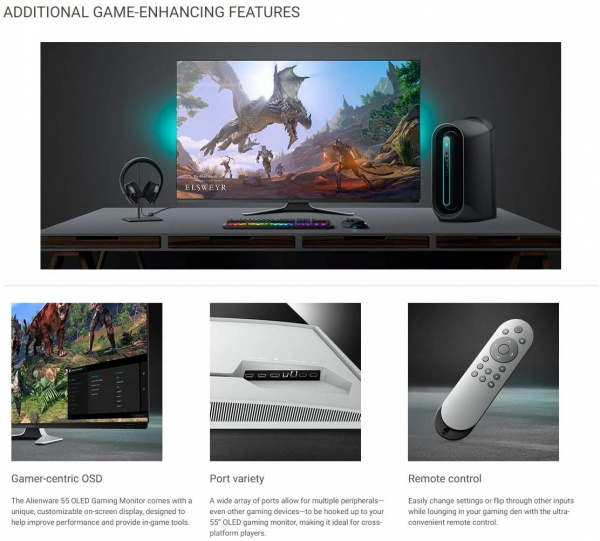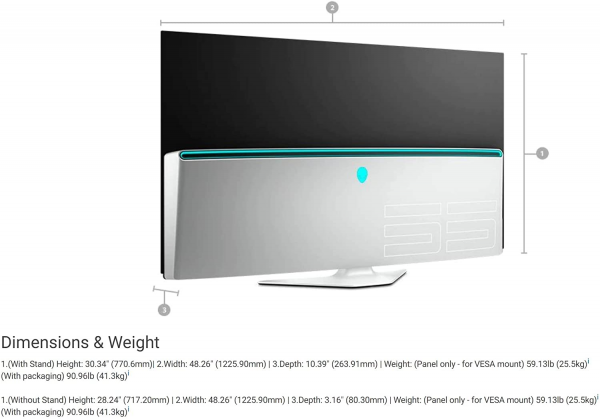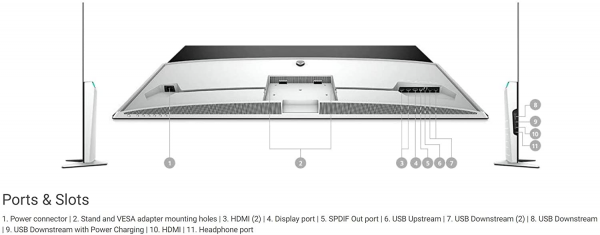Alienware
Alienware AW5520QF: the only Oled Ultra HD monitor on the market is a giant
Aprox. 3977€ - see price -
See specificationsAlienware's first Oled monitor is as big as a TV (55 inches!). It is distinguished by the presence of the DisplayPort and its FreeSync compatibility. Is it enough to prefer it to a TV? This is what we will see ...
Positive points
Default image quality.
Infinite contrast.
Instant response time.
Support for Ultra HD at 120 Hz.
Compatibility FreeSync, AdaptiveSync and by extension G-Sync.
Open viewing angles.
Remote control supplied.
Bad points
No system for inserting black images.
Limited ergonomics (no inclination adjustment or height adjustment).
Requires a very deep desk.
Higher display delay than the best Oled TVs.
Limited brightness.
Lack of HDR compatibility.
Our review
Presentation
The Alienware AW5520QF monitor has a 55-inch Oled panel with an Ultra HD resolution of 3,840 x 2,160 px from LG Display. It is identical to that which equips Oled televisions from LG, Sony, Panasonic, Philips and all the manufacturers of Oled televisions. But as we will see, it does not behave at all in the same way, probably to respond to specific use on a computer. Another difference, there is no tuner or video processor to improve the image. However, this Alienware monitor has speakers and a remote control. It stands out above all from televisions by its FreeSync / AdaptiveSync compatibility and the presence of a DisplayPort input allowing you to enjoy Ultra HD at 120 Hz. This combination of definition and refresh rate is theoretically accessible to the latest Oled televisions equipped with HDMI 2.1 input , like LG models, but no graphics card currently has an HDMI 2.1 output, not even the most expensive (GeForce RTX 2080 or Radeon VII) or the most recent (GeForce RTX 2080 Super or the Radeon RX 5700 XT). It is therefore mandatory to go through the DisplayPort to take advantage of such a display frequency in Ultra HD on an Oled panel of this size.
The Alienware AW5520QF clearly charges its difference and its exclusivity since it is announced at almost € 4,000, or at least twice the price of an Oled TV equipped with the same Oled panel as the Panasonic TX-55GZ1000.

Ergonomics
Unsurprisingly, the AW5520QF looks like a TV with a central stand. From the front, the design is surprisingly sober for an Alienware product. The brand just puts its name on the bottom of the screen, and that's it.
At the back, we finally find the Alienware touch with a light strip and the brand logo illuminated by RGB LEDs. The power supply on the left and the connectors on the right have a guide for the cables which leads them to the base of the foot. A magnetic cover hides the whole. It's much cleaner than on TVs.
There is nothing to say about the finishes. They are exemplary, but we expect no less for a product at this price level.
The connectors are distributed in two places. On the back, there are two HDMI 2.0 inputs, a DisplayPort 1.4 input, an optical digital audio output (SPDIF) and two USB 3.0 ports. On the side, two USB 3.0 ports, an HDMI 2.0 input and a headphone output. The monitor also has two 10 W speakers whose rendering approximates what good TVs do. In terms of audio quality, we are far above what monitors usually offer.
The screen does have six buttons for accessing the OSD, but the remote control is much more practical for managing the various settings. This remote control also allows you to use the monitor as a TV by allowing the source to be changed and the volume to be adjusted. The monitor offers some options for players, such as the display of an overlay viewfinder, a timer or even a frame counter per second (which actually displays the refresh rate ...). The image settings are quite limited (brightness, contrast, sharpness). Finally, it is possible to customize the six buttons on the screen for direct access to presets, FreeSync, volume, brightness, sources, etc.
The foot is only 26.4 cm deep. It is not much for a 55 inch monitor and, above all, the back of the stand is contained which allows the screen to be only 15 cm from the wall. However, this monitor is not suitable for everyone. On our reference desk measuring 140 x 60 cm, the monitor is at ease, but the distance is not enough to take advantage of this diagonal. If this decline may be acceptable in office automation, at the cost of a permanent head movement, it is not enough to play. We are placed at least 1 meter from the screen to enjoy sufficient distance in fast games (FPS type). Surprisingly, the resolution of 80 pixels per inch on this 55-inch Ultra HD panel is not coarse with a recoil of only one meter. This resolution also makes it possible to use the native definition under Windows 10 without any scaling and thus to benefit from a substantial workspace while maintaining good readability.
The maximum brightness does not allow to exceed 116 cd / m². With this brightness, the Alienware AW5520QF monitor consumes 74 W, or a relative consumption of only 89 W / m². It is difficult to say if this model is economical since it does not reach the target value of 150 cd / m² which we use to compare the consumption of the monitors. In addition, the consumption of an Oled panel depends on the content displayed. With a very bright image, consumption is higher than on a conventional LCD monitor, while with a dark image, consumption will be lower. At a minimum of brightness (26 cd / m²), it still consumes 57 W.

Colors and contrast
Like televisions, the Alienware AW5520QF monitor is perfectly calibrated right out of the box. The average temperature measured at 6,590 K - very close to 6,500 K of the video standard - and, above all, the curve is stable over the entire spectrum. The gamma is of the same ilk, with a very smooth curve and an average of 2.2 set on that of reference. In terms of color fidelity, if some shades exceed a delta E of 4, the mean (2.5) is less than 3, a threshold below which the eye can no longer distinguish the color drift.
Calibration using a colorimetric probe does not improve things. With an average delta E of 2.4, the colors are not better and the other curves are identical.
The contrast measured on Oled screens is simply perfect since it is considered to be infinite. Indeed, each pixel can be turned off individually and the black is thus perfectly black, without any blooming effect (halo effect around a bright object on a black background). The native contrast of the panel thus exceeds all that is currently done on the monitor market. The problem remains the maximum brightness limited to around 115 cd / m², which is lower than our recommended value of 150 cd / m² for office use, and this can clearly be problematic in bright places. On an entirely white test pattern, the brightness even drops to 90 cd / m². Alienware has obviously chosen to curb the performance of the slab in order to avoid marking.
Recommended article: Lab - Alienware AW5520QF: a latest generation Oled panel limited in brightness
The average difference in white homogeneity is only 4% on the 55-inch panel, a real feat made possible thanks to the use of Oled technology. There is thus no variation in the brightness perceptible to the eye. Obviously, there is no light leakage in the corners nor any clouding ("cloud effect"). Finally, the Oled also offers very good viewing angles.
One of the weak points of this monitor is the very partial support of HDR with limited brightness compared to Oled TVs, as we saw in this dedicated article:
The Oled Alienware AW5520QF monitor has a 55 inch Oled Ultra HD panel identical to that found on TVs, ...
Reactivity
Oled technology does not use Pulse Width Modulation (PWM) to vary the light intensity and there is therefore no image flickering. On the other hand, this monitor does not have a system for inserting black images that can deceive retinal persistence and therefore improve the sharpness of moving objects. It is all the more unfortunate that the Oled technology benefits from zero persistence resulting in the absence of ghosting, but there is still a blur caused by the eye which can only be deceived via this stratagem. Remember that LG, Philips, and Sony use this black image insertion system and that there is no problem with the panel. Leaving to offer an Oled monitor at this price, we would have liked Alienware to integrate all the available technologies.
This monitor manages FreeSync and G-Sync between 30 and 120 Hz and therefore works optimally when the graphics card sends between 30 and 120 images per second. The supported range is therefore very wide and covers all uses. We will still recommend a very powerful graphics card, especially for playing in Ultra HD. In all cases, the fluidity is there and the image does not suffer from tearing problems or jerks (micro-stuttering).
We measured the remanence time at only 1 ms. Indeed, our device filming at 1000 images per second cannot measure a remanence of less than 1 ms. In fact, the remanence of an Oled screen is even less than 0.1 ms. The monitor does not offer overdrive adjustment to reduce ghosting since there is simply none. On the other hand, we measured the delay in the display (input lag) at 29.9 ms (at 60 Hz). A rather high value for a monitor and especially compared to Oled TVs whose best (like the LG 65C9) go down to 13 ms. The delay in display is less than two images compared to the source, but for a monitor intended for gamers, this is a bit of a shame.
Conclusion
First Oled monitor for gamers, the Alienware AW5520QF pays a premium price. At this price, it displays a perfectly calibrated image, an unrivaled remanence time, infinite contrast, FreeSync compatibility (G-Sync by extension) and it is also one of the few monitors to support a frequency of 120 Hz in Ultra HD. However, it is not free from defects, the most important being the lack of HDR compatibility; a shame for a product equipped with a latest generation Oled panel delivering a superb image in HDR, but it is probably a must to avoid marking problems.
Specifications

